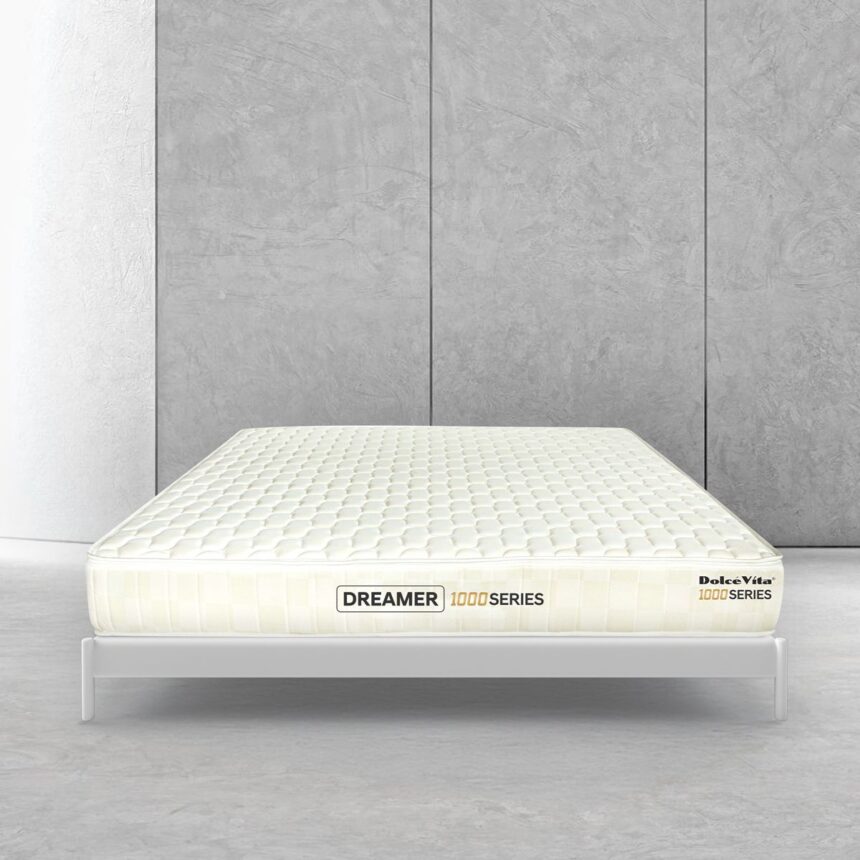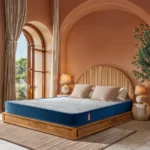Introduction
When buying a mattress, the question almost always arises – with or without springs. Each option has its own characteristics, and the choice depends on what is important to you. In this article, we will analyze the difference between spring and springless models, what are their advantages and where there are limitations.
Spring Mattresses
How Spring Mattress Works
The mattress is based on a spring block. Types of spring blocks will be considered below. After the spring block, layer by layer, there are flooring materials. In combination, they form a sleeping surface, give a certain level of rigidity, comfort, height and orthopedics. In this case, the number and design of springs play a crucial role.
Each spring is packed in a separate fabric pocket and compresses independently of the adjacent ones. Due to this, the mattress precisely adjusts to the body and supports the spine without kinks and tension.
What’s On Top Of The Springs
In spring mattresses, the so-called “comfort layers” are located above and below the spring block: artificial latex, coconut, memory foam, natural latex or a combination of these materials
Types Of Spring Blocks
Dependent Bonnel Springs
The simplest and most budget block of springs, in which all elements are connected.
Each spring is packed in a separate pocket made of fabric and is compressed independently of the others. Due to this, the mattress does not bend completely – it reacts pointwise to weight, supporting the back straight. This type of design is the most common: it is easy to find it in different price categories, from basic to reinforced models.
There are almost twice as many springs – due to this, the support becomes more accurate, and the mattress lasts longer. Such a block holds its shape well, especially in models of the middle price category.
In the S2000 block – up to 1000 springs per square meter. This is almost twice as much as in conventional models, so the mattress adapts better to the body and does not lose its shape over time. Such blocks are well suited for those who weigh more than average or simply like tight and even support.
Inside each large spring there is an additional one of a smaller diameter and height. Under light load, only the external element works. If the weight increases, the internal spring is also engaged, creating a second level of support. Such a block is especially convenient for couples with different builds – the mattress adapts to each without losing stability.
Block with alternating zones of different hardness. Compensates for uneven distribution of body weight. Recommended for those who sleep on their side. In this case, the number of springs can be any.
Advantages And Disadvantages Of Spring Mattresses
Pros
- Low price. Steel in a spring block is cheaper than any other mattress fillers (polyurethane foam, latex, coconut coir and others), so a spring mattress will cost less than a springless counterpart of the same height and the same materials.
- A wide range of models. If you want to choose a high mattress for the bed, then among the products with a spring block, there are more suitable options for the price.
- Variety of designs. It doesn’t matter what weight you have or what position you are used to sleeping in – you can find a suitable option among the spring blocks. If you need reinforced support, S1000 or S2000 blocks are suitable. For a standard weight and on a tight budget, it’s wise to consider TFK – it provides basic comfort without overpaying.
- High anatomical due to the wide operating range of the spring compression.
Cons
- It is not recommended to jump and walk on a spring block.
- Noise. In cheap spring mattresses with thin flooring layers, the work of individual spring elements can be felt.
- The electromagnetic field, albeit in extremely small quantities, is still present.
- It is undesirable to use in rooms with high humidity.
Spring Mattresses. Findings
Spring mattresses are still one of the most popular options. They give the usual feeling of support, withstand different weights and do not require special care. Modern models work quietly and do not creak. If stability and comfort are important, such a mattress is suitable.
Take a closer look at these models of spring mattresses
Spring Mattresses That You Can Buy Right Now:
Springless Mattresses
How A Springless Mattress Works
In springless mattresses, instead of springs, the load is distributed by layers of materials – most often foam, latex or coconut. Rigidity, elasticity and comfort depend on their combination and thickness. Such mattresses do not spring, do not creak and do not transmit movement.
How Foam Works In A Springless Mattress
The foam adjusts to the curves of the human body and supports the spine in the correct position.
What Besides Foam
In a springless mattress, there is usually a “comfort layer” above and below the foam: coconut, artificial or natural latex, memory foam or various combinations of materials
Types Of Springless Mattresses
Monolith Is The Basic Option
Made of one type of material. Such a mattress has a symmetrical firmness. The cost of such a mattress depends on the material used.
Such mattresses use several layers with different properties. The upper part is usually responsible for comfort – it is softer and adapts to the curves of the body. The bottom layer is stiffer and denser, it does not allow the mattress to bend under the weight. Many models have different sides in firmness: you can turn the mattress over if it has become too soft or, conversely, you want more comfort. This is convenient when it is difficult to decide on preferences or in the summer you want to sleep on a less dense surface.
In this design, soft latex is combined with hard coconut. One layer is responsible for comfort, the other for support. The mattress does not wrinkle at the edges, holds its shape and withstands the weight. It is chosen by those who need support for the back, but without excessive rigidity.
Advantages And Disadvantages Of Springless Mattresses
Pros
- Perfect load distribution. The anatomical effect is achieved by adjusting hundreds of thousands of pores inside the material at once against a limited number of springs.
- Absolute silence. There are no parts inside such mattresses that can creak. This is a good option for those who sleep lightly and wake up from any noise.
- No vibrations or fluctuations. The absence of mechanical elements completely eliminates the possibility of the surface waving due to a change in the partner’s posture or the feeling of instability when you sit down or roll over.
- Roll packaging. More models per roll with almost free delivery throughout Pakistan. It is convenient to lift such a roll yourself to the floor or take it to a country house.
- Simple and technologically advanced design. Less risk of damage to the product during operation.
- High environmental friendliness. Less or no glue is used during assembly.
- Bed base. For springless people, both any orthopedic grille and a solid base are suitable.
- No electro-magnetic fields.
Cons
- Cost. The price of a mattress with high-quality fillers will exceed the cost of a spring counterpart.
- Density of polyurethane foam (polyurethane foam, artificial latex). The need to study the composition when buying a springless mattress that includes polyurethane foam, since low-density material is often used in budget models.
- It has a small margin of safety and durability. If you do not have time to understand such nuances, it is better to contact our consultant for a selection.





